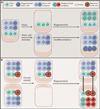Hardwiring Stem Cell Communication through Tissue Structure
- PMID: 26967287
- PMCID: PMC4805424
- DOI: 10.1016/j.cell.2016.02.041
Hardwiring Stem Cell Communication through Tissue Structure
Abstract
Adult stem cells across diverse organs self-renew and differentiate to maintain tissue homeostasis. How stem cells receive input to preserve tissue structure and function largely relies on their communication with surrounding cellular and non-cellular elements. As such, how tissues are organized and patterned not only reflects organ function, but also inherently hardwires networks of communication between stem cells and their environment to direct tissue homeostasis and injury repair. This review highlights how different methods of stem cell communication reflect the unique organization and function of diverse tissues.
Copyright © 2016 Elsevier Inc. All rights reserved.
Figures



References
-
- Adams GB, Chabner KT, Alley IR, Olson DP, Szczepiorkowski ZM, Poznansky MC, Kos CH, Pollak MR, Brown EM, Scadden DT. Stem cell engraftment at the endosteal niche is specified by the calcium-sensing receptor. Nature. 2006;439:599–603. - PubMed
-
- Barker N. Adult intestinal stem cells: critical drivers of epithelial homeostasis and regeneration. Nature reviews Molecular cell biology. 2014;15:19–33. - PubMed
Publication types
MeSH terms
Grants and funding
LinkOut - more resources
Full Text Sources
Other Literature Sources
Research Materials

